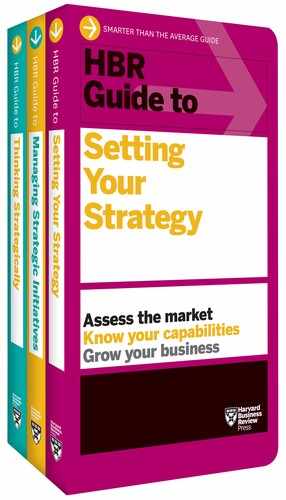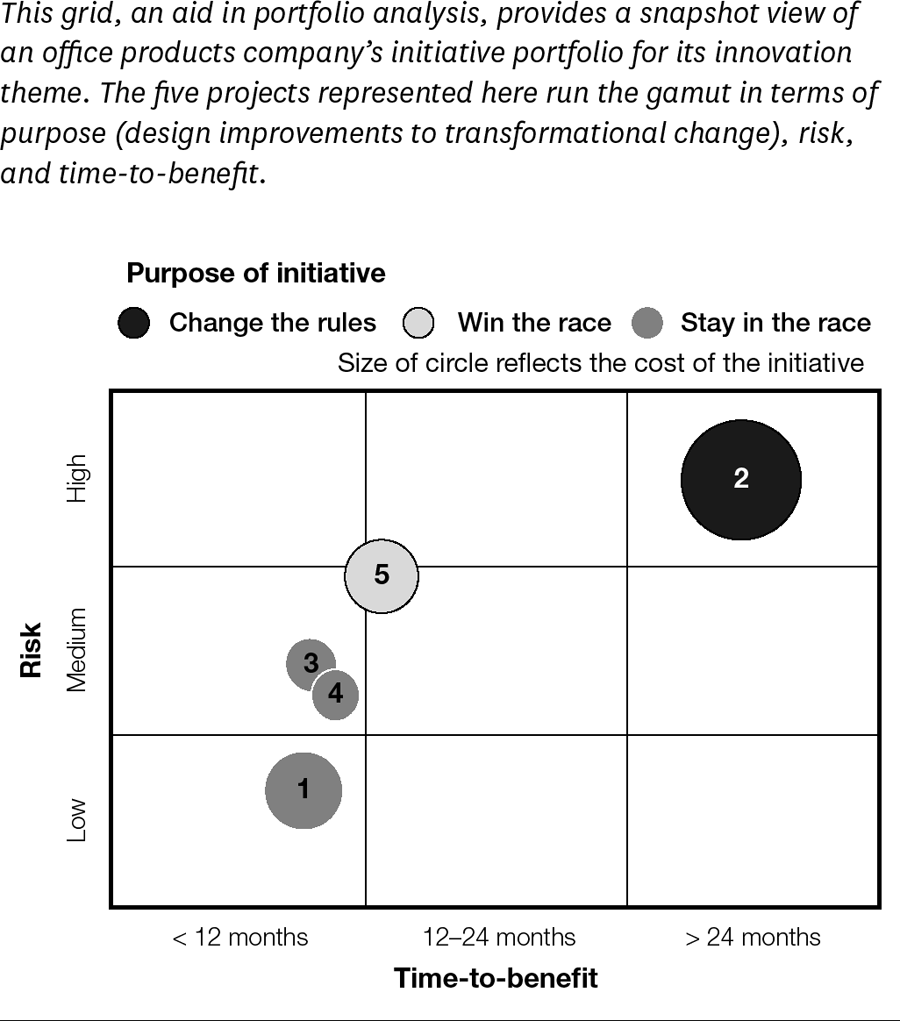CHAPTER 8
Rebalance Your Initiative Portfolio
by Peter LaCasse
The concept of initiative portfolio management is derived from sound investment practice. A good financial adviser ensures that each client has a balanced portfolio, with an appropriate mix of investments in stocks, bonds, money market, and other asset classes. In choosing this mix, the adviser considers many factors, such as the client’s date of retirement, future income needs, and risk tolerance, among others. As things change, the adviser tweaks the mix on an ongoing basis. For example, if stocks represent 40% of a client’s portfolio but quarterly returns from them exceed that percentage, the adviser will need to rebalance the stock allocation to maintain the portfolio’s original risk levels.
Initiative portfolio management should follow this portfolio balancing approach, where you evaluate each project in the context of the total portfolio. Unfortunately, most companies select initiatives independently of one another, with little regard for their impact on other efforts. They should review the business case for each initiative in the larger context to consider its impact on other initiatives. This prevents overweighting investments to short-term results that risk mortgaging the organization’s future, prevents investing too much in a particular strategic theme at the expense of others, and simply helps avoid projects that are too risky. (See the sidebar “A Case Example.”)
A CASE EXAMPLE
The web division of a large retail bank defined its five-year strategy in terms of four strategic themes: market share growth/business development (sales), market protection/maintaining customers (web channel use), process efficiency, and organizational learning. Division leaders wanted to focus on expanding the web as a sales channel without losing ground in the other areas. After developing strategic objectives and aligning existing projects with the themes, the leaders learned that the company was spending most of its discretionary dollars on retaining customers and driving web channel use—to the detriment of the other themes.
However, as the leaders pushed for more projects geared toward sales growth, they did not overlook the other elements of a balanced portfolio. To balance the portfolio’s risk profile, they maintained a healthy investment in keeping their current customer base if the new product ideas failed to catch hold in the marketplace. They also made sure that the returns from their projects aligned to their short-, medium-, and long-term (division) targets. In the short run, they felt that by freeing up 20% of their discretionary spending and an even greater percentage of their employees’ time, they could apply those resources to projects more closely aligned to the strategy. For example, they invested in building the capability to sell products that the company had never before sold on the internet, rather than in enhancements to online checking and savings account services.
Once an enterprise establishes portfolio categories based on its strategic themes, each business unit should use the portfolios to organize its discretionary spending. Units then present their project portfolios to enterprise leaders, who can more readily assess how well the portfolios are balanced against overall strategy. In reviewing the portfolios collectively, the leaders can ensure that each division is doing its part to support the strategy of the whole company.
Preparing Initiatives for a Portfolio Management Approach
Organizations that follow the disciplined initiative management process already have detailed information on each project. They have already developed a business case when first proposing an initiative. Initially a set of high-level assumptions within a concept document, the case is refined into a detailed proposal document once the idea is approved and/or sponsored. This document addresses the project’s goals, strategic impact, financial costs and benefits, time to implement, time to benefit, skills and capabilities required, and implementation and impact risks. If the detailed proposal passes leadership review, companies finalize the business case and develop a project plan.
The detailed business case information enables companies to regularly evaluate their initiative portfolios. Canadian Blood Services (CBS), the nonprofit that manages Canada’s blood supply provides a good example of this process. The organization’s leadership team spent three days evaluating its initiative portfolios. The portfolios were based on CBS’s strategic themes, “Safety,” “Operational Excellence,” and “Prepare for Tomorrow.” The team seemed to have allocated its initiatives appropriately across the three themes. But when team members looked at risk and benefit levels within each theme, the portfolios now seemed off balance. For example, in the theme Prepare for Tomorrow (about expanding business into new areas), most of the initiatives were medium to low risk and of medium benefit. The only initiative actually designed to help CBS expand into new areas was focused on developing its (umbilical) cord blood bank capabilities. Team members recognized that the strategic theme focused on changing their business should contain initiatives that would truly transform it. This realization spurred conversation, leading to the idea of expanding into such areas as organ transplants and tissue bank services that could further capitalize on CBS’s process expertise. Now the team could easily see the gaps in each portfolio and develop initiative ideas to fill them. According to CEO Graham Sher, this portfolio framework “allowed us to have the difficult conversations about which initiatives to include or eliminate,” adding that the total cost of slashed initiatives “equaled millions of dollars.” Balancing the initiative portfolio, Sher observes, has helped CBS make the link between strategy and operations explicit.
Portfolio analysis should be the first step in rebalancing the initiative portfolio, as it provides the necessary data for discussion and decision making. Leaders examine the amount invested (both financial and human resources) in each theme, the skills and capabilities required to deliver on the portfolio’s initiatives, the organizational change required, the aggregate risk within the portfolio, and the anticipated changes and benefits. They then weigh these requirements against the organization’s available budget and human resources, inventory of skills, and capacity to support change, as well as the desired level of performance. Portfolio analysis is often best represented in multiple formats, including graphical and written. (See the sidebar “Keeping It Honest.”)
KEEPING IT HONEST
Many organizations struggle to justify their initiatives. Overzealous managers write business case proposals that claim unrealistic benefits or underestimate costs. But there is a way to ensure business case legitimacy and prevent ill-founded initiatives from passing muster. By making leaders accountable for each business case and incorporating initiative and portfolio performance into their regular strategy performance reviews, organizations can remove the bias and fluff from proposals. Knowing that they will be held accountable for delivering their forecasted benefits and working within their own estimated budgets, leadership team members tend to be more realistic. Embedding such accountability into the process will invariably result in more pleasant surprises than unfortunate miscalculations.
Figure 8-1 is an example of a nine-cell grid, a graphical tool for evaluating theme initiative portfolios. Initiatives are classified by their purpose (“stay in the race,” “win the race,” or “change the rules”), risk level, and time to benefit. This example represents an office-product company’s portfolio of initiatives within its strategic theme of innovation. Projects 1, 3, and 4 involve enhancements to the company’s stapler, pen, and desk organizer product lines. These projects, aimed at maintaining competitiveness, are relatively low cost and designed to yield short-term results. Project 2, a transformative initiative, involves developing an entirely new line of products, which will require creating new production capabilities, distribution partnerships, and new marketing. Project 5, geared toward gaining market share, involves marketing an existing product in a new region, which will require establishing a new distribution channel as well as a marketing campaign. The overall portfolio balances the short-term need to fend off competition and expand market share with the longer-term goal of exploring new markets and establishing new sources of revenue.
Making It Stick
Most investors would agree: A financial adviser who analyzes the client’s portfolio only once a year is not doing his or her job. The same goes for initiative portfolio analysis. The leadership team needs to review and update portfolio needs regularly. Repeated project reviews and progress reports provide the necessary information. The team should promptly note and assess project changes for their impact on the whole portfolio. For instance, if one project’s risks rise during implementation, does the portfolio contain appropriate projects that are a backup in case the project fails? Companies that are investing in a new product area, for example, will want to maintain an existing program to retain current revenues. Quarterly reviews are best, but regularity is most crucial; if left only to when executives have time, the reviews will almost never happen.
In practice, developing a portfolio review process takes time and effort. At first, initiative portfolio reviews often seem like regular project reviews, where leadership team members know little about parts of the business outside their direct functional responsibility. Over time, however, leaders realize the importance of understanding the entire business in making portfolio trade-off and balancing decisions. Discussions become more substantive, and leaders take a true team approach to making project portfolio decisions.
__________
Peter LaCasse is Chief Product Officer at Carnegie Learning. He was formerly Initiative Management Practice Leader at the Palladium Group.
Adapted from “Rebalance Your Initiative Portfolio to Manage Risk and Maximize Performance,” Balanced Scorecard Report, September–October 2008 (product #B0809D).

